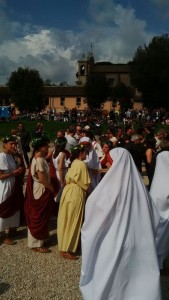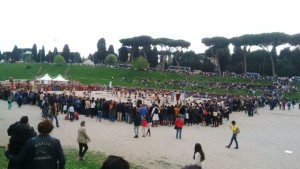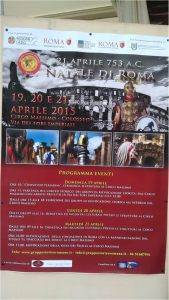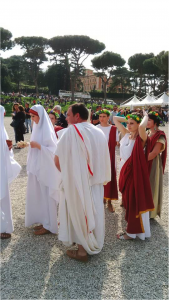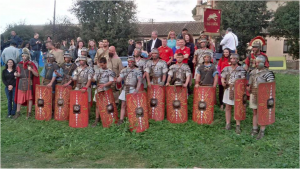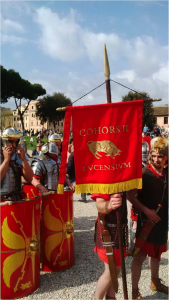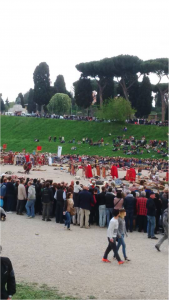The 21st April was identified as the birthday of Rome (a dies natalis for the city) as is made clear by Cicero and coincided with the festival of the Parilia. The linkage to this festival is made via the fact that Romulus’ and Remus’ “foster-father” – Faustulus was a shepherd, a fact Varro considered all in the Late Republic to have known. Thus, although living in antiquity’s largest metropolis with ¾ of a million others, ancient Romans understood the pastoral origins of the city. The foundation of the city by Romulus commemorated the connection to a culture of sheep and shepherds for Varro (see section 9 of book 2 via this link).
The celebration of the Parilia involved the lighting of bonfires to purify sheep-pens. Undertaken by shepherds at twilight with the addition of chemicals to the fire to create a distinctive coloured smoke. The burning of specific types of wood: juniper, olive and pine would have created a very distinctive smell to the smoke. Ovid in the Fasti (4. 721) provides further details – see this link for a recent translation of his text). Interestingly, in Ovid’s account, the day of Rome’s birth – the Parilia – was not the day Romulus began to define the city, but the day on which Remus mocked his efforts and is killed. Plutarch in his Life of Romulus (12) suggests that the day was never celebrated with a blood sacrifice of an animal to keep the day pure and ‘without the stain of blood’, because it celebrated the birth of their country. That birth would seem to have been, for Ovid at least, stained with the blood of Remus.
Activity:
Why do people in antiquity celebrate the birth of Rome?
What is the role of Remus in Rome’s foundation myth?
By the second century AD, Athenaeus (8.361e-f) sees the Parilia being an ancient festival supplanted by Hadrian’s festival called the Romaia – celebrated with the sounds of drums, pipes, cymbals and song. A celebration that occurred every year by all in Rome, whether inhabitants or visitors. It was also on this day that the Temple of Venus and Rome was founded by the emperor Hadrian close to the Colosseum at the point described by Suetonius as in media urbe.
Activity:
Use the internet to locate the remains of the Temple of Venus and Rome. How is this temple distinctive and very different from others in Rome? What architectural innovations can you identify?
Today, in Rome, people still celebrate the foundation of their city on the 21st of April. Vikrant Rao, a student studying at Kent’s Postgraduate Centre in Rome last year (2015) experienced the celebration in the city. The photos below and this link to these two films film 1, film 2 capture that experience.
Activity:
Examine the photos below and consider the following questions:-
Why do you think the focus of re-enactment and commemoration centres on the Roman Army?
What other forms of commemoration might be considered?
How might you re-enact the festival of the Parilia http://www.novaroma.org/nr/Parilia?
Natale di Roma by Vikrant Rao (Kent Alumnus)
During one of many casual ‘dawn to dusk’ walks last year through the historic centre of Rome, I stumbled upon celebrations marking the 2,768th birthday of Rome. To put this in perspective, America as a nation is just a little over 200 years old and though there are older continually inhabited cities in the world, Rome is probably the most continually inhabited, ‘Capital’ city in existence. Unfortunately, the Natale di Roma event isn’t aggressively promoted on the tourist circuit even though it is one of the most unique events around. I came across it by sheer chance and made sure I returned the following day for some great selfies and conversations. In case anyone wonders how old this ‘celebration’ is, the foundation date of April 21st, 753 BC was proposed by First Century BC Roman historian Varro, whereas, the modern celebration one witnesses today began in 1870 when Italy became a unified Republic.
The experience of Natale di Roma reminds one of a large outdoor party where everyone is friends and there’s plenty of beer, wine, gelato and stuffed paninis to go around! Natale di Roma is an intimate and fun experience unlike any. On the Sunday closest to the 21st there is a procession of die-hard enthusiasts belonging to volunteer clubs dressed from head to toe in Legionary armour displaying the insignia of the Roman legion they’re supposed to represent. They are followed by a mix of Gladiators playing the part, Senators in bright togas with purple borders and grass crowns, Roman matrons and mistresses dressed in colourful fabrics with their hair loose, the procession tries to portray the rank and file of Roman society. It then winds its way past the Colosseum and Arch of Constantine towards the Circus Maximus where they assemble for the main show. For some strange reason, these ‘legionnaires’ marching between the Arch of Constantine and the Colosseum seem to blend right in!
At the Circus Maximus, possibly the largest outdoor arena in the world one gets the sense that half of Rome has turned up for the spectacle. The enthusiasts perform re-enactments of key events in Rome’s history with everything from the foundation of the city by Romulus and Remus (Yes, they bring the wolves too!) to the purge of the Christians during Nero’s reign. The battle re-enactments are particularly interesting because they are done very professionally. Anyone who has played ‘Total War Rome 2’ or watched the movie, ‘The Eagle’ will recognise when they pull off a near perfect Testudo formation. The victorious Romans bashing swords against shields before entering battle, understandably a lot of the re-enactment is dominated with the Romans battling the barbarians. The whole experience though is thoroughly entertaining. For a moment it feels as if the cast of ‘Gladiator’ had merged with HBO’s Rome!
One can also purchase cool memorabilia at promotional rates like swords, helmets, insignia…etc. You can try on a body armour to get a sense of how much weight they carried back in the day or wield a Roman gladius just for the fun of it, fire a ballista (catapult) a few feet or wrestle with a Gladiator in tights if that’s your thing! So, whether you’re a fan of Roman warfare, a budding film-maker or just someone interested in hairstyles from Antiquity, this re-enactment would be perfect for you.
As I realised, climbing up the slope on either side of the Circus for a better view, one could look directly into the arena just as the ancient Roman would have done.
Bibliography
Beard, M. 1987. ‘A complex of times: No more sheep on Romulus’ birthday’ Proceedings of the Cambridge Philological Society 33: 1-15
Wiseman, T.P. 1995. Remus, Cambridge University Press pp.1-18
Beard, m. Price, S.R.F. and North, J. 1998. Religions of Rome, Cambridge University Press volume 1 pp.174-6 and volume 2 pp. 116-19


